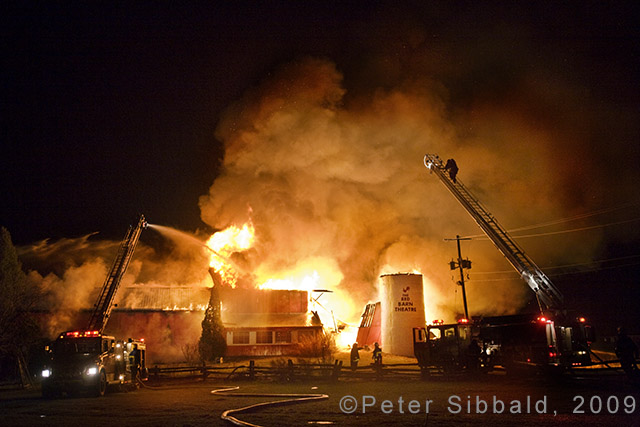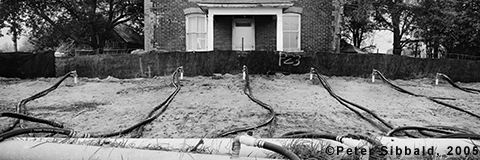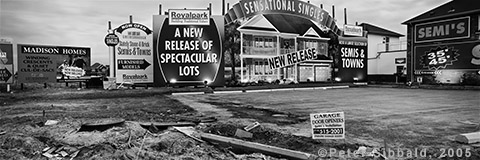
Jackson's Point, Ontario Canada. Firefighters from the Georgina Fire Department battle to keep the fire at The Red Barn Theatre from spreading to the surrounding brush and nearby senior's residence. In the end all that survives the fire is the barn's signature silo. ©Peter Sibbald, 2009. All Rights Reserved.
Last night The Red Barn Theatre gave it’s final performance. To an audience of fewer than one hundred, mostly comprised of family, Briars Resort employees, friends, neighbours, Georgina Mayor Rob Grossi and over 30 fire fighters of the Georgina Fire Department, the Red Barn —my family’s barn— in its final and arguably most spectacular performance, burned to the ground.
Theatre historian David Gardner is researching the history of the Red Barn and a small synopsis of his research into The Barn’s illustrious history can be found on the Red Barn Theatre web site at http://redbarntheatre.ca/working/aboutus_history.html . Originally erected in the early 1800s and rebuilt by my Great-Great Uncle Frank Sibbald in the 1870s to be the family barn attached to The Briars, then being run as a farm, The Barn—as it has simply come to be known—has played stage to nearly everyone who was anyone in the Canadian theatre and music scene for 59 years. This was to have been its 60th season. Created as a theatre by Toronto-born actor Alfred Mulock in the spring of 1949, and leased from my grandfather Jack Sibbald, then Reeve of Georgina for $1.00, The Red Barn was one of the first professional summer theatres in Canada, predating even the Stratford and Shaw festivals.
Like so many Canadian cultural institutions, The Barn has always operated very close to, or below the line. From Brian Doherty in 1950, who would go on to found The Shaw Festival, Vern Chapman who would become the President of Canadian Actor’s Equity through Bill Glassco who would found Toronto’s Tarragon Theatre, The Barn has run through a tumultuous history of financial struggle from the first season onward. Management was finally somewhat stabilized when it was transferred to the not-for-profit Lake Simcoe Arts Foundation, founded by my father John Sibbald in 1973. Under their auspices, and a series of professional theatre managers and artistic directors, The Barn has been the labour of love for a small army of volunteers and a grateful recipient of Town of Georgina and provincial arts funding. Throughout the theatre’s history and for all but a few years in the early 1960s, the Red Barn Theatre and surrounding 7½ -acre property has been owned and its use donated by Briars Estates Limited of the Sibbald family.
From 1986 to 2007, The Barn played home to the Peter Gzowski Invitational Golf tournament gala performances when Canada’s household names gave generously of their talents to help Peter Gzowski realize his intention to “raise a few bucks” for literacy, fund-raising for Frontier College. Celebrities have included Peter Mansbridge, Loreena McKennitt, Valdy, Natalie McMaster, The Barenaked Ladies, Laura Smith, Ashley MacIsaac, Cynthia Dale, Murray McLauchlan, Pamela Wallin, John McDermott, Susan Aglukark, Ron Maclean, Tom Jackson, and Shelagh Rogers along with Poets Laureates Tim Findlay, Michael Ondaatje, Margaret Atwood, Dennis Lee and Sheree Fitch, to name but a very small few.
If the barn was lost, the Georgina Fire Department nonetheless successfully managed to contain the blaze, keeping it from spreading to the neighbouring field, woodlands and senior’s complex. York Regional Police have secured the site, and the Ontario Fire Marshall is on the scene and has begun his investigation. The cause of the fire is still unknown.
As neighbours and volunteers wept in the waning glow of the fire at the periphery of the property, murmurs of renewed fund-raising efforts, rebuilding and “the show must go on” could be heard in the semi-darkness. Plans for the upcoming season remain undetermined.
_______
Other coverage:







Recent Comments